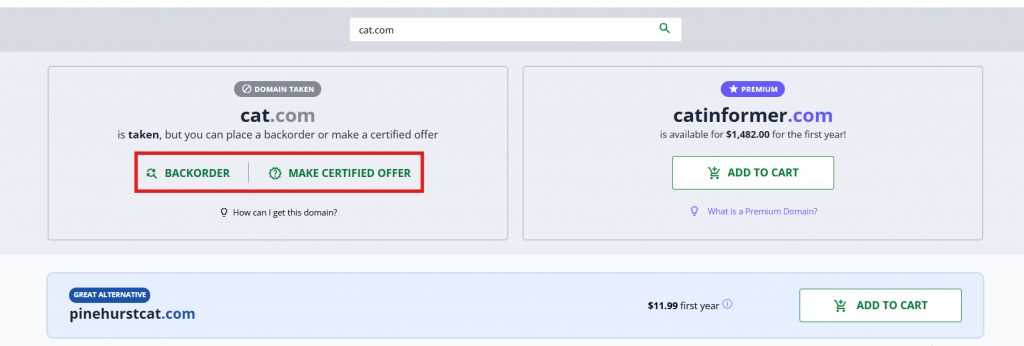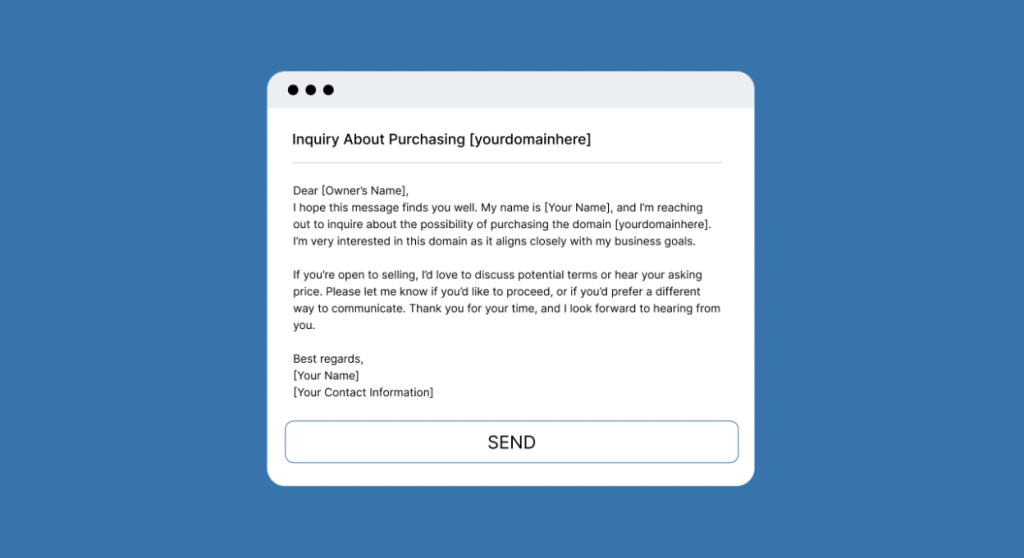Key takeaways:
- The domain’s availability depends on whether the current owner actively uses it, is saving it for future projects, or has listed it for sale.
- Before buying a domain, ensure there are no legal risks involved. Researching the domain’s legal status protects you from costly setbacks.
- You can acquire a taken domain name through various methods. Each method has its pros and cons depending on the domain’s availability and your budget.
Finding the perfect domain for your business is exciting—until you realize it’s already taken. Don’t worry. Even if your dream domain isn’t available right now, you could still make it yours.
In this guide, we’ll explain how to buy a domain name that is taken and help you navigate the process. From identifying the owner to negotiating professionally, you’ll learn everything you need to know about getting a used domain name.
How to buy a domain name that is taken
These are the steps to buying a taken domain name:
- Check for trademarks and legal issues
- Research the domain’s history
- Examine the SEO performance of the domain’s website
- Determine the domain’s value
- Identify the domain owner with WHOIS lookup
- Reach out professionally
- Change domain ownership
We’ll be covering each step in more detail later on. But first, let’s go over what domain ownership entails, why people purchase domains, and how it all affects you.
Understanding domain ownership and how it affects your purchase
No one truly owns a domain. Instead, the domain registries give you the right to use a domain. To secure it, a company or individual registers the domain with an accredited domain registrar. Once registered, no one else can claim it for a particular period.
The registration period lasts between one and ten years and must be renewed to keep the domain. By paying for domain registration, a domain owner can keep it off the market—even if not actively used.
Here’s why your ideal domain name might already be taken:
- Tied to an active website. The current owner uses it for their business or personal brand. If the domain is critical to their online presence, they might not want to sell it, or they may demand a high price.
- Saved for future projects. Some domains are parked for later use. However, owners may be open to selling if they no longer need the domain or if they find your offer attractive.
- For sale. Many domains are held as investments. Owners register them expecting the value to increase over time. Such domains are sold at a premium, especially if they have strong demand.
- Protected by domain expiration policies. Some domain owners purchase Domain Expiration Protection. This allows them to keep temporary ownership of the domain after it expires.
Understanding the domain owner’s intent can help you decide how to approach them. But before taking any steps, it’s essential to check for potential legal risks tied to the domain.
Step 1. Check for Trademarks and Legal Issues
When buying a domain, check for any legal risks to avoid costly mistakes or damage to your brand. Neglecting this step could lead to a loss of time, money, and other resources down the line.
Here’s what to keep an eye on:
- Trademark infringement
- General Data Protection Regulation (GDPR) protected domains
- Cybersquatting and domain disputes
Trademark infringement
Some domains are protected by trademarks and using them without permission could land you in legal trouble. Trademark violations can lead to having to relinquish the domain or paying hefty fines. To avoid this:
- Check the United States Patent and Trademark Office (USPTO) database to ensure the domain name isn’t already trademarked.
- Verify that the domain name doesn’t conflict with international trademarks. Use resources like the World Intellectual Property Organization (WIPO) or regional databases like USPTO or European Union Intellectual Property Office (EUIPO).
- Check whether the domain has been involved in any prior trademark disputes or legal cases using the platforms above.
General Data Protection Regulation (GDPR) protected domains
The GDPR of Europe has changed the way WHOIS data handles domains. You’ll find may EU-based domains have been masked under its rules. If this is the case, the only way to reach out to the owner of a taken domain would be through a domain broker or marketplace.
Cybersquatting and domain disputes
Watch out for cybersquatting, where someone registers identical or similar sounding domains to sell later for a profit. Perpetrators often target established trademarks and pressure them into buying the domain back at an inflated price. This is a legal risk you must take seriously.
- Anti-cybersquatting Consumer Protection Act (ACPA). Familiarize yourself with the ACPA. It protects consumers from bad-faith domain registrations related to trademarks. This law allows trademark holders to reclaim domains that infringe upon their brand.
- Uniform Domain Name Dispute Resolution Policy (UDRP). Get acquainted with UDRP as well. It is a global system for resolving domain disputes. Understanding how the dispute process works will help you navigate the complexities of domain ownership issues.
Step 2. Research the Domain’s History
Check if the domain was previously used for scams, spam, or any other shady activities. The domain’s history and reputation can impact your brand’s image.
- Tools like the Wayback Machine can help you check what the domain was used for in the past.
- Google search can also reveal if the domain was previously associated with malicious activities or blacklisted.
- SEO tools like SEMrush and Ahrefs can help uncover any hidden SO penalties tied to the domain. SEO penalties can harm your SEO efforts when you launch your site.
Taking these extra measures might seem time-consuming, but they’ll protect your brand’s reputation and save you from costly setbacks along the road.
Step 3. Examine the SEO performance of the domain’s website
Evaluate the domain’s search engine optimization (SEO) performance by looking at its backlink profile, traffic history, and relevance to your brand. A domain with strong SEO can give you a head start, while weak SEO could require cleanup.
- Backlink quality. Use tools like Moz, Ahrefs, or SEMrush to inspect the domain’s backlink profile. Good backlinks from reputable sources boost your chances of ranking well, while bad backlinks (especially from spammy sites) can do the opposite and even trigger penalties.
- Traffic history. Tools like SimilarWeb or Google Analytics (if you can access it) can show you past performance. You want to see if the domain had consistent organic traffic or if it experienced sharp declines. Sudden drops in traffic could signal penalties, poor management, or irrelevant content from the past.
- Relevance to your brand. Even if a domain has strong SEO, it still needs to align with your business. If the domain was previously used for something completely unrelated, rebranding it could confuse users and take longer to build trust. A domain that already fits your industry and audience will have more weight with search engines and your visitors.
Step 4. Determine the Domain’s Value
A taken domain name comes at a cost, and you’ll need to know whether or not it’s within your budget. Here are a few things to factor in:
- Domain age. Older domains tend to cost more because they’ve had time to build authority. A newer domain might be cheaper but could lack the same reputation or search engine trust.
- Keywords and searchability. Domains with high-demand keywords are often more valuable because they’re easier to find in search results. For example, a name like Coffeeshop.com is broad, highly searchable, and appeals to a wide audience. In contrast, LatteForTwo.com is more niche and may not attract as much general traffic.
- Comparable sales. See what similar domains have sold for. If CoffeeShop.com is your target, look into past sales for names like CoffeeHouse.com or LocalCafe.com. These could have sold for anywhere between $2,000 and $5,000.
Here are three of the best tools you can use to evaluate the domain’s worth.:
- Estibot. Estibot is a leading domain appraisal tool that provides an instant estimate based on factors like domain age, keyword strength, backlinks, and traffic potential. It’s one of the most reliable options for getting a solid ballpark figure for a domain’s value.
- DomainIndex. DomainIndex offers detailed appraisals and a scoring system based on search engine performance, backlinks, and other metrics. It’s useful for understanding a domain’s market value and SEO potential.
- Sedo (Paid Service). Sedo offers paid domain appraisal services, which can help you understand a domain’s market value based on current trends and comparable sales.
Note: These tools will at least give you a number to work with, but ultimately, it comes down to how much the owner values the domain.
Step 5. Identify the domain owner with WHOIS lookup
Find out who owns the domain. Knowing the domain owner helps you identify if the domain is for sale and decide how to approach the negotiation process.
The current owner also plays a key role in determining how valuable the domain might be:
- Big companies. If a large business owns the domain, it’s likely tied to their active website or branding. This could make it expensive, or even impossible, to acquire.
- Small businesses or individuals. These owners are often more open to selling, especially if the domain isn’t critical to their operations. They may also be willing to negotiate a fair price.
- Domain investors. Investors buy domains as assets and are usually open to selling. However, they tend to hold onto high-value domains for better offers. These domains often include premium domains with strong keywords or market appeal.
The WHOIS database stores ownership details for a registered domain. Use these steps to find the contact details of the owner:
- Visit ICANN or WHOIS lookup.
- Enter the specific domain name you’re interested in.
- Look for contact details, such as an email address or phone number.
What if the details are private?
Some domain owners use privacy protection to hide their WHOIS information. If that happens, a privacy service email will appear instead. You can send a message to this email. Some registrars will stilll forward your inquiry to the domain owner.
If not, then here are alternative methods to find the domain owner when WHOIS details are private:
- Look for domain-related content or a website
- Check with your domain registrar
Look for domain-related content or a website
Look for any domain-related content or a website associated with the domain. Even if the WHOIS details are protected, you might find the owner’s information elsewhere.
Check if there’s an active website. It might have a contact form or email address you can use to contact the domain owner. If the site’s down, social media accounts might also provide a way to reach the owner.
Check with your domain registrar
Your own registrar may have domain marketplaces you can use to secure the taken domain name. They may not advertise these services upfront, but it’s easy to spot. If the domain you want is unavailable, you’ll usually see an option below it to either backorder or make a certified offer.

- Backorder. When a domain expires, it doesn’t go back into circulation right away. The current owner is given a chance to reclaim it. Backorder services allow you to acquire the domain as soon as it becomes available after the owner’s grace period runs out.
- Make certified offer. This is a more proactive approach. You submit an offer for the domain, and the registrar passes it on to the owner, who can then accept or reject it. It’s essentially a way to put your best offer forward without direct negotiation.
The downside to this method is that you’re not really negotiating so you won’t really know why the seller turns down an offer or if they’re asking for a higher rate.
The good news is if you conduct the transaction through your registrar, payment channels are secure, and they typically handle the ownership transfer for you, making the process smoother and safer.
Step 6. Reach out professionally
When it’s time to contact the domain owner, how you approach them can make all the difference. Here’s how to position yourself for success:
- Maintain a friendly yet professional tone. Be respectful and professional in your approach. Introduce yourself clearly and explain why the domain matters to your project or business.
- Be direct. A thoughtful message can spark interest. However, respect the owner’s time by keeping your communication clear and to the point.
- Negotiate with confidence. Come prepared with a fair price based on your research. Most domain owners appreciate it when a buyer makes thoughtful offers that reflect the domain’s value.
Sample email to contact the owner
Here’s an example of an email you can use:

If the owner doesn’t respond right away, don’t lose hope. Follow up politely after three to five days and limit yourself to two or three attempts. Persistence is valuable but you want to avoid overwhelming the owner.
If you don’t hear back from the owner or you’re not comfortable reaching out directly, consider:
- Buying through a domain marketplace (if listed there)
- Hiring a domain broker
If you’d like to know how to do these, we’ve covered them both in more detail below.
Buying through a domain marketplace
Buying a domain listed on a marketplace is the easiest and most secure way to make a purchase. If the domain name is available there, reach out through the platform directly. Here’s why it’s a smart choice:
- Ease of negotiation. Marketplaces often have pre-set processes for making offers. This can make negotiations smoother and faster.
- Transparency. Marketplaces typically display the domain’s asking price, recent bids, or fixed sale prices. You can gauge the value of the domain name right away and decide whether or not it’s right for you.
- Secure transactions. Many marketplaces offer built-in escrow services to ensure secure payments and domain transfers, protecting both the buyer and seller.
One thing to keep in mind is that domain marketplaces mainly handle the pricing, negotiations, and finalization of the sale. After that, the transfer and re-registration process is in your hands. The good news is that many registrars offer their own domain marketplaces, making the purchase and transaction process easy and secure.
Hiring a domain broker
If you’re not comfortable negotiating directly with the domain owner, you can hire a domain broker to handle it on your behalf. Brokers specialize in buying and selling domains, especially when it comes to securing the best deal.
However, they take a commission from the sale. This is why most buyers first reach out to the domain owner directly and only work with a broker as a last resort.
Here’s how a broker can help if you need one:
- Handle negotiations. Brokers are skilled at getting deals done and can manage tricky back-and-forth discussions.
- Save time. Can’t find the contact details or don’t have the bandwidth? A broker will do the heavy lifting for you.
- Provide market insights. Brokers know the domain market and can help you make a fair offer without overpaying.
A broker can be especially helpful when dealing with high-value or premium domains, but their fees mean it’s worth trying direct contact first.
How to choose the right domain broker
Choosing the right broker is important when securing your domain. Here’s what to look for and why it matters.
- Experience. Look for a broker with a strong track record. Experienced brokers are skilled at handling complex negotiations and ensuring successful deals.
- Specialization. Some brokers focus on premium or niche domains. A specialist is better equipped to handle high-value transactions and provide targeted advice.
- Clear terms. Make sure the broker provides a detailed breakdown of their fees and services. Be cautious of extra charges, such as appraisal fees or rush services.
- Strong reviews. Check out testimonials from previous clients. Look for reviews on their website, industry forums, or trusted review platforms to ensure reliability.
Pros and cons of a domain broker
Hiring a domain broker can be a great move, but it may not always be the right choice. Here’s a closer look at the benefits and drawbacks of domain brokers:
Pros
- Saves time. Brokers handle everything from finding contact details to negotiating the final deal. This is especially helpful if you’re short on time or unfamiliar with the process.
- Expert negotiators. Brokers are skilled in navigating complex discussions and can often secure better terms than you might on your own.
- Industry insights. With their deep knowledge of the domain market, brokers can help you make fair offers and avoid overpaying for your domain.
Cons
- Costly fees. Brokers typically charge a percentage of the domain’s price. For high-value domains, this fee can add significantly to the overall cost.
- Less control. When working with a broker, you hand over the reins for communication and negotiations. This means you won’t have direct input during the process.
- Limited expertise. Not all brokers specialize in the type of domain you’re looking for. If they lack experience with niche or premium domains, you might not get the results you’re hoping for.
List of domain brokerage services for acquiring a taken domain
If you decide to hire a broker, choosing a reliable service is important. Here are some trusted options to consider:
| Platform | Domain type | Key features | Best for |
| GoDaddy Auctions | Premium, Expiring | Search filters for expired and premium domains Secure payment WHOIS protection during transfer | Buyers looking for auction-based or expired domains |
| Sedo | Premium, Brokered | Extensive domain marketplace with international reach Secure domain transfer transactions Domain valuation tools Private broker assistance available | Premium domain buyers and international reach |
| Flippa | Premium, Used Domains | Easy to navigate interface Dedicated category for domains Marketplace for websites and domains Transfer and escrow services available | Entrepreneurs looking for used domains and websites |
| Afternic | Premium, Brokered | Large inventory of premium domains Supports private negotiations and broker services Quick transfer process with escrow | Buyers looking for premium domains and fast transfer |
| DomainAgents | Premium, Brokered | Direct negotiation with domain owners Professional mediation and brokered services Confidential and secure process Offers both buy-it-now and bidding options | Buyers looking for a negotiated domain acquisition with privacy |
| Network Solutions’ Certified Offer Service | Premium, Brokered | Allows anonymous offers to domain owners Secure transaction process Professional brokers help mediate the sale | Buyers who want to discreetly acquire a specific domain that’s already registered |
Step 7: Change domain ownership
Once you’ve purchased the domain, the final step is transferring ownership. To do this correctly, it’s important to understand the difference between a domain transfer and an ownership transfer.
- A domain transfer refers to moving a domain from one registrar to another, but the owner of the domain stays the same. This typically happens when you want to manage all your domains from a single provider or streamline your services.
- An ownership transfer involves transferring the legal rights of a domain to another entity. This occurs when you purchase a domain from someone else, making you the official owner.
Since you’ve bought the domain from someone else, you’re performing an ownership transfer. Afterward, if the domain isn’t with your registrar, you can do a domain transfer.
How to change domain ownership
Here’s a quick and general overview:
- Unlock the domain. The current owner will need to unlock the domain through their registrar’s account settings.
- Update the contact information. Both the current and new owners must ensure their contact details are accurate.
- Initiate the transfer. The current owner can initiate the ownership transfer directly within their registrar account, sending an ownership request to the new owner.
- Authorize the transfer. The new owner will receive a transfer request, which they need to authorize. This often involves entering a code provided by the registrar.
- Accept the transfer. The new owner receives the request, reviews the details, and accepts the transfer.
The transfer usually takes five to seven days to finalize, depending on the registrar and how quickly both parties act. For detailed assistance, contact your current registrar’s customer service.
What if the domain is not for sale?
If your attempts to contact the domain owner haven’t worked and the domain remains unavailable, it’s time to explore other options. Here are some alternatives to consider:
- Slight domain name variations. Try adding prefixes, suffixes, or small spelling changes to make the domain unique. For example, if CoffeeShop.com is taken, consider MyCoffeeShop.com or CoffeeShopOnline.com.
Need inspiration? Use our AI Domain Generator to brainstorm ideas. It can suggest variations that fit your branding while keeping your domain name relevant and memorable.
- Alternate domain extensions. Consider using another top-level domains (TLDs) like .net, .org, or.co. Specialized extensions, such as .tech or .io, can also work if they align with your industry or audience.
- And if you really have your heart set on the domain name, you could also add hyphens. Just make sure you don’t infringe on anyone.
- Consider rebranding. Sometimes, a creative name change opens more possibilities. Rebranding gives you the flexibility to choose a domain that reflects your business while maintaining originality.
Claim your perfect domain
Buying a taken domain name doesn’t have to be a daunting task. With the right strategies and resources, you can secure the perfect domain for your business.
Once you’ve secured your domain, you can use our AI website builder to easily create and customize your website. It’s a do-it-yourself tool, so you stay in control while building a site that fits your needs.
Frequently asked questions
You can use a WHOIS lookup tool to find the domain owner’s contact details. If the information is private, check the domain’s website for a contact page or email address. Social media platforms can also be helpful for tracking down the owner.
Yes, buying from trusted marketplaces like Sedo is generally safe. They verify sellers, offer secure payment methods, and ensure a smooth transfer process. These protections make them a reliable choice for domain purchases.
If the owner doesn’t reply, wait a few days and send a polite follow-up. If there’s still no response, you can hire a domain broker to negotiate on your behalf. Alternatively, you can explore similar domain names or variations.
Yes, there are many great alternatives like .net, .org, or niche options like .io and .tech. Choose an extension that fits your brand and appeals to your audience.
Most domain transfers take about 5 to 7 days to complete. The process depends on how quickly the current owner approves the transfer and the registrars involved.
Avoid domains that are too similar to existing trademarks or copyrighted names. Always research the domain thoroughly before buying and consult a legal expert if you’re unsure.
Yes, you can wait for a domain to expire, but it’s not always guaranteed to be available immediately. If you’re serious about securing the domain when it becomes available, you can use a backordering service to increase your chances of getting it. These services help ensure you don’t lose out when the domain is released.




